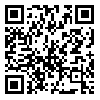Volume 9, Issue 35 (vol. 9, no. 35 2020)
2020, 9(35): 87-99 |
Back to browse issues page
1- University of Hormozgan
2- University of Hormozgan ,shamili@ut.ac.ir
2- University of Hormozgan ,
Abstract: (3533 Views)
According to the upward rate of the production and release of nanoparticles in nature, it is nessesary to consider about the possibility of toxicity and oxidative damage to plant ecosystem. So this research aimed to compare biochemical and antioxidant indices of Onion treated with different concentrations of two types of silver nanoparticles (green synthesis and chemical synthesis) and exploring the probability of oxidative stress induction. In this study, the leaf extract turning from pale yellow to dark brown, due to surface plasmon resonance of silver nanoparticles, indicated the successful synthesis of silver nanoparticles. The absorption spectrum of the synthesized silver nanoparticles shows a peak with λmax of 410 nm. TEM images revealed a uniform size of the synthesized particles, with almost spherical shape and the size range between 3-10 nm, with an average of 5.8 nm. XRD analysis revealed that green synthesized silver nanoparticles are crystalline in nature. According to the results, both antioxidant enzymes represented linear increases in exposure to the chemical nanoparticles. Both nanoparticle caused the increase in lipid peroxidation, but green synthesized nanoparticles had no significant difference with control. The most phenol content belonged to chemical nano-silver (15.16 mg galic g-1 FW at a concentration of 0.05 gr l-1) and the least value to control (4.1 mg galic g-1 FW). The antioxidant activity of chemical nanoparticles was 8 times larger than the green nanoparticles. According to the results of this research, green nanoparticle not only did not have an oxidative effect on onion, but also some stimulatory effect was seen. But, the chemical nanoparticles, provoked plant defense reactions, by inducing oxidative stress, besides the inhibitory effect was dose-dependent.
Type of Study: Research |
Subject:
Toxic ions stress
Received: 2019/05/25 | Accepted: 2019/08/2 | Published: 2020/05/9
Received: 2019/05/25 | Accepted: 2019/08/2 | Published: 2020/05/9
| Rights and permissions | |
 | This work is licensed under a Creative Commons Attribution-NonCommercial 4.0 International License. |



